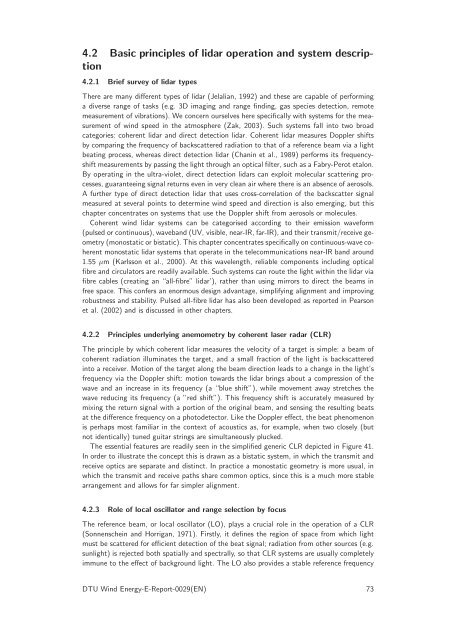Publishers version - DTU Orbit
Publishers version - DTU Orbit
Publishers version - DTU Orbit
Create successful ePaper yourself
Turn your PDF publications into a flip-book with our unique Google optimized e-Paper software.
4.2 Basic principles of lidar operation and system description<br />
4.2.1 Brief survey of lidar types<br />
There are many different types of lidar (Jelalian, 1992) and these are capable of performing<br />
a diverse range of tasks (e.g. 3D imaging and range finding, gas species detection, remote<br />
measurement of vibrations). We concern ourselves here specifically with systems for the measurement<br />
of wind speed in the atmosphere (Zak, 2003). Such systems fall into two broad<br />
categories: coherent lidar and direct detection lidar. Coherent lidar measures Doppler shifts<br />
by comparing the frequency of backscattered radiation to that of a reference beam via a light<br />
beating process, whereas direct detection lidar (Chanin et al., 1989) performs its frequencyshift<br />
measurementsbypassingthelightthroughan opticalfilter, suchasaFabry-Perotetalon.<br />
By operating in the ultra-violet, direct detection lidars can exploit molecular scattering processes,<br />
guaranteeingsignalreturns even in very clean air where there is an absence ofaerosols.<br />
A further type of direct detection lidar that uses cross-correlation of the backscatter signal<br />
measured at several points to determine wind speed and direction is also emerging, but this<br />
chapter concentrates on systems that use the Doppler shift from aerosols or molecules.<br />
Coherent wind lidar systems can be categorised according to their emission waveform<br />
(pulsed orcontinuous),waveband(UV, visible, near-IR,far-IR), and theirtransmit/receive geometry(monostaticorbistatic).Thischapterconcentratesspecificallyoncontinuous-wavecoherent<br />
monostatic lidar systems that operate in the telecommunications near-IR band around<br />
1.55 µm (Karlsson et al., 2000). At this wavelength, reliable components including optical<br />
fibre and circulators are readily available. Such systems can route the light within the lidar via<br />
fibre cables (creating an “all-fibre” lidar’), rather than using mirrors to direct the beams in<br />
free space. This confers an enormous design advantage, simplifying alignment and improving<br />
robustness and stability. Pulsed all-fibre lidar has also been developed as reported in Pearson<br />
et al. (2002) and is discussed in other chapters.<br />
4.2.2 Principles underlying anemometry by coherent laser radar (CLR)<br />
The principle by which coherent lidar measures the velocity of a target is simple: a beam of<br />
coherent radiation illuminates the target, and a small fraction of the light is backscattered<br />
into a receiver. Motion of the target along the beam direction leads to a change in the light’s<br />
frequency via the Doppler shift: motion towards the lidar brings about a compression of the<br />
wave and an increase in its frequency (a “blue shift”), while movement away stretches the<br />
wave reducing its frequency (a ”red shift”). This frequency shift is accurately measured by<br />
mixing the return signal with a portion of the original beam, and sensing the resulting beats<br />
at the difference frequency on a photodetector. Like the Doppler effect, the beat phenomenon<br />
is perhaps most familiar in the context of acoustics as, for example, when two closely (but<br />
not identically) tuned guitar strings are simultaneously plucked.<br />
The essential features are readily seen in the simplified generic CLR depicted in Figure 41.<br />
In order to illustrate the concept this is drawn as a bistatic system, in which the transmit and<br />
receive optics are separate and distinct. In practice a monostatic geometry is more usual, in<br />
which the transmit and receive paths share common optics, since this is a much more stable<br />
arrangement and allows for far simpler alignment.<br />
4.2.3 Role of local oscillator and range selection by focus<br />
The reference beam, or local oscillator (LO), plays a crucial role in the operation of a CLR<br />
(Sonnenschein and Horrigan, 1971). Firstly, it defines the region of space from which light<br />
must be scattered for efficient detection of the beat signal; radiation from other sources (e.g.<br />
sunlight) is rejected both spatially and spectrally, so that CLR systems are usually completely<br />
immune to the effect of background light. The LO also provides a stable reference frequency<br />
<strong>DTU</strong> Wind Energy-E-Report-0029(EN) 73

















